► We drive the Lucid Air in Europe
► S-Class space, Tesla pace, futuristic face
► RWD and AWD models, every spec tested
Have you heard of the Lucid Air? As a discerning reader of CAR magazine, you might’ve been busy watching the Californian start-up’s progress from tiny Tesla wannabe to become one of the most interesting electric car brands on the planet. But we’ll forgive you if this is the first you’ve heard of it. After all, you can’t buy one in the UK, there is no right-hand drive configuration available (yet) and there are just six Lucid Motors dealers in central Europe who’ll actually sell you a car today. We’d forgive you for dismissing it as another irrelevant start-up.
However, our advice is to ignore Lucid at your peril. We’ve tested the full range of Lucid Airs at the European launch: we sampled everything from the new, cheaper rear-wheel drive Pure model, which ditches the second motor to reduce the €€€ and heady power outputs, to the more powerful GT trims, which add toys and power galore. The range is burgeoning and that’s before anyone’s got to sample the insane Lucid Air Sapphire trim coming this autumn, which will out-accelerate a Bugatti Chiron Pur Sport and anything that Elon Musk can throw at it.
Air is the debut product from Lucid Motors, a company built from the ground-up by Peter Rawlinson, one of the engineering maestros behind the early Teslas (not to mention Jaguar and Lotus).
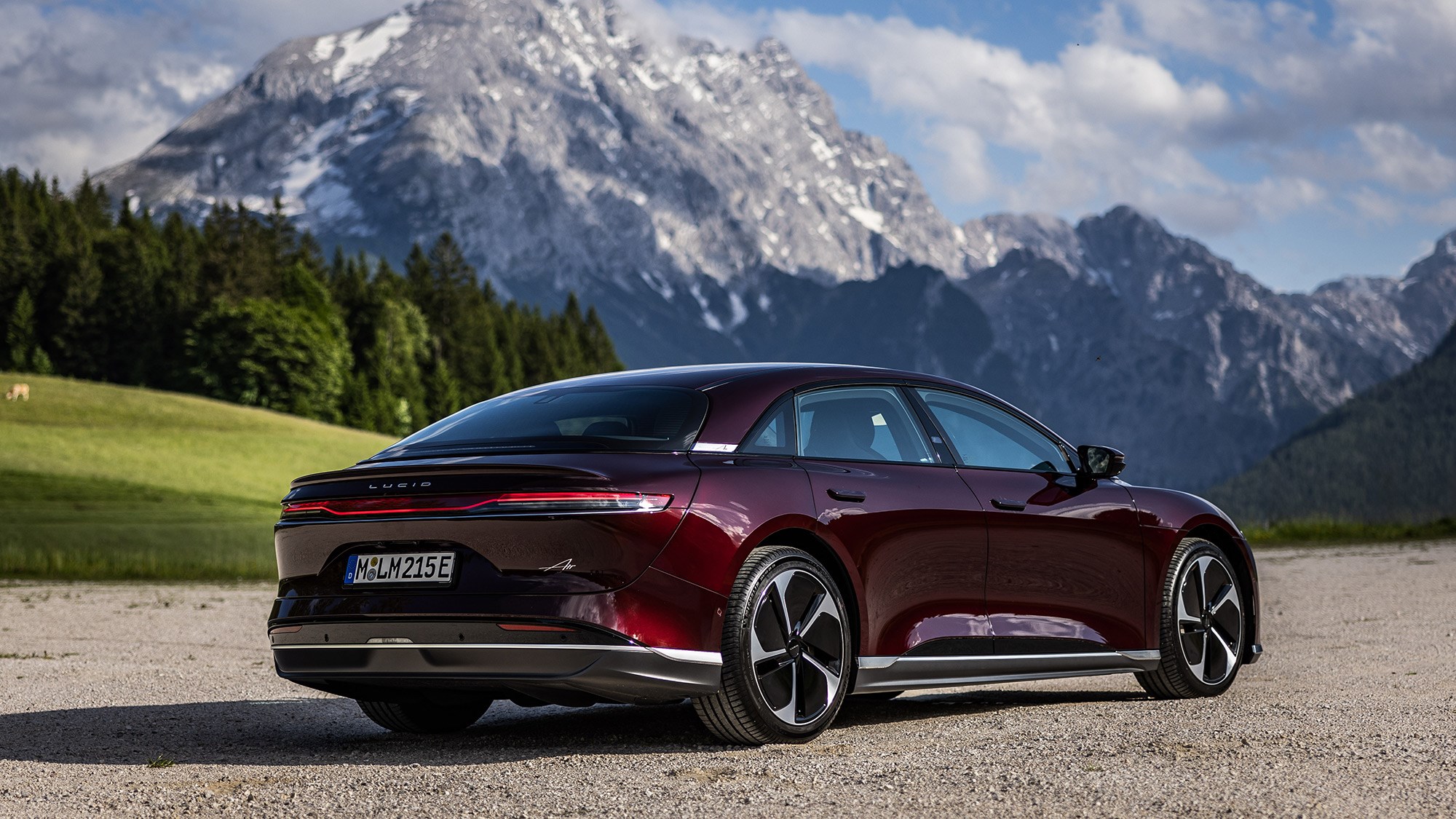
Here’s another reason to believe: it’s majority owned by PIF, the Saudi sovereign wealth fund, which means it has seismically deep financial backing to fund the clever tech. It ain’t cheap to launch a premium electric car brand from scratch, but the Saudis pumped in $1 billion earlier this year in return for getting a Lucid factory of their own in the Middle East.
Read our detailed Lucid Air review to find out why we rate this electric car as one of the hottest EV prospects around – and why it deserves the success lavished upon rival Californian disruptor Tesla who got there first. Here is one electric car that can teach the ancien régime a trick or two…
Pros: Space efficiency, energy efficiency, rock-solid build quality, driving dynamics… nearly everything, in fact
Cons: Lucid Air is destined to remain a left-hand drive launch model; prices are still out of reach for many
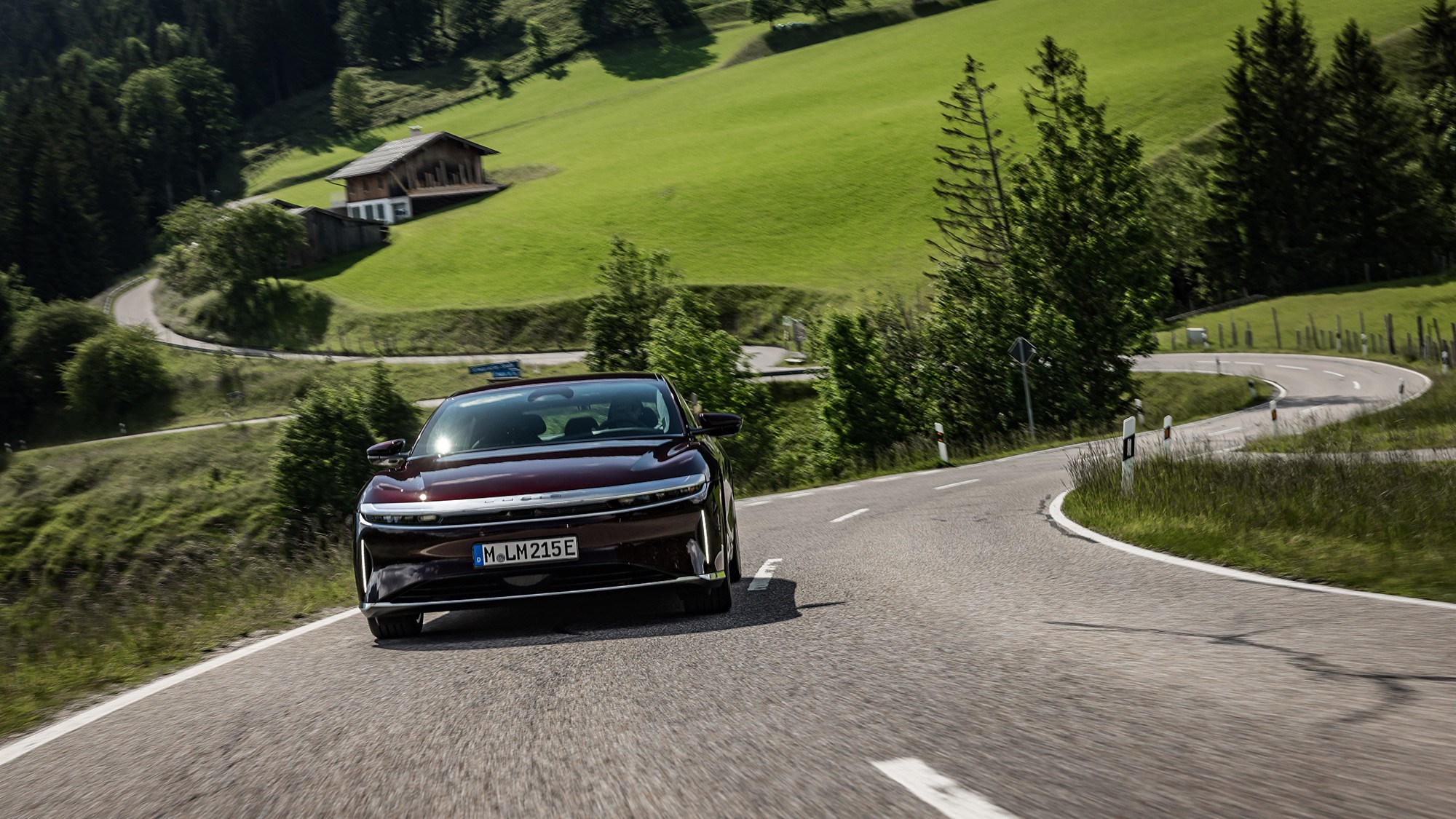
What’s new on the Lucid Air?
Everything, really. The Lucid Air launched in the US in 2021 on a bespoke architecture sharing nothing with other EVs, but sales are only just getting underway in selected European countries. The launch here coincides with the new ‘decontented’ two-wheel drive Pure version tested here for the first time; it shrinks the battery capacity down to 88kWh, drops the second motor and culls the price to a more attractive €85,000, equivalent to £71,800 at time of writing.
Approach the Air for the first time and it looks like a burgundy alien spacecraft. The wheelbase is within a millimetre of the Tesla Model S, and overall length similar, but the Air is a narrower car. It’s a touch longer than a Porsche Taycan but as roomy as a Mercedes-Benz S-Class. The proportions are beguiling and the promise of EV range up to 464 miles in the Pure is extraordinary for any electric car, let alone one so large and luxurious. Go for a higher spec and the WLTP range soars beyond 500 miles.
The secret to Lucid’s energy efficiency lies in its adherence to ‘vertical integration,’ engineering shorthand for keeping everything inhouse: platform, motors and transmission (which in itself is a unique and innovative design), all of the battery elements bar the cells, and much more besides. The Air is the opposite of a bitsa parts-bin special and doesn’t use off-the-shelf motors from a regular or garden supplier. When you see the incredibly compact – and muscular – integrated Lucid e-motor, you’ll understand how they’ve packaged so much space into the car.
Lucid Air vs BMW i5 and Nio ET7: electric sports saloon face-off
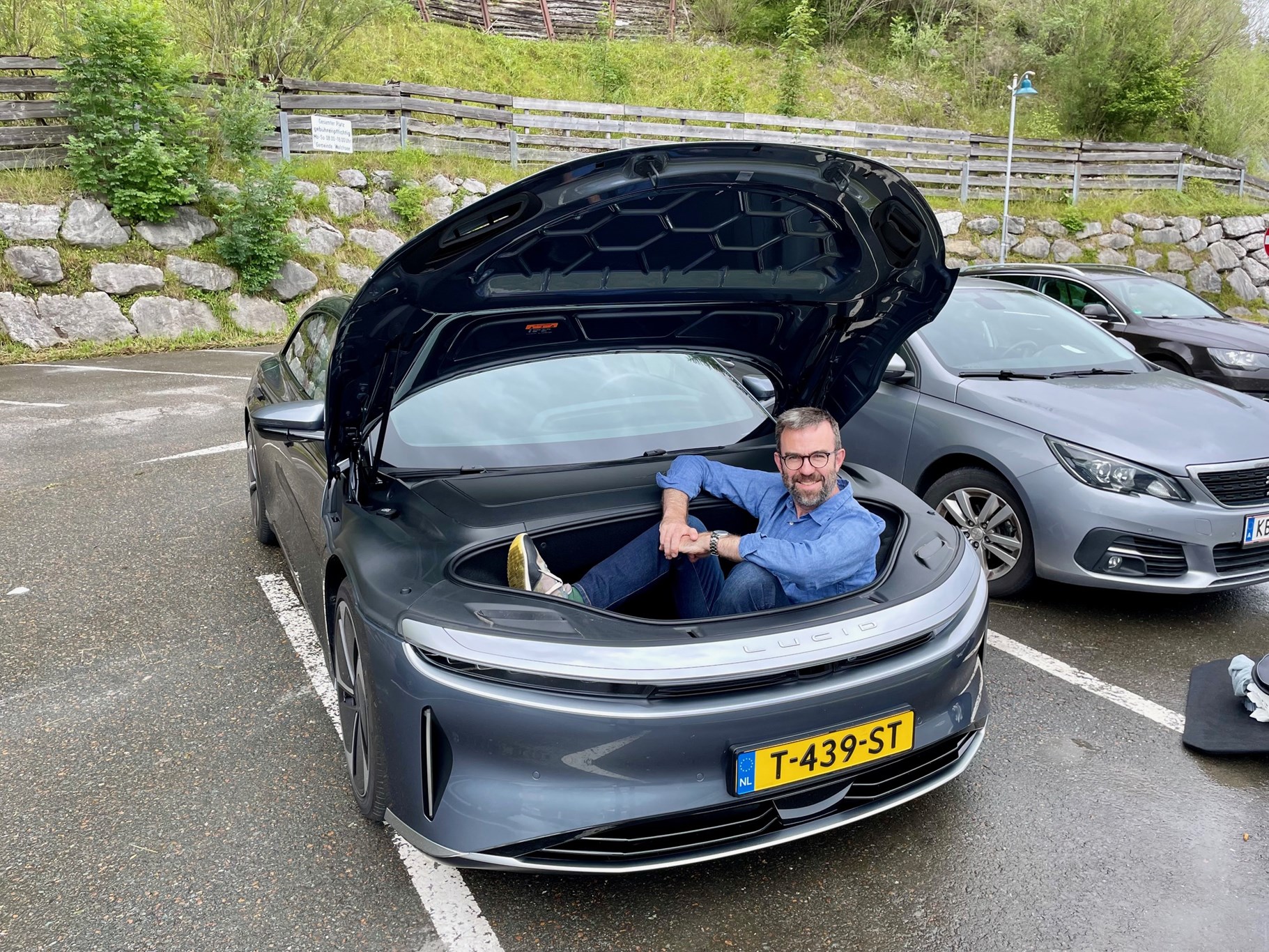
There’s much that’s innovative about the Air, and Lucid’s approach as a company, in ways you sense would be more difficult for a ‘legacy’ manufacturer starting without a blank sheet in front of them. The cleverly moulded battery modules which enable the unusually roomy cabin; the way the entire front-end assembly is as low as possible, for both style and reduced drag, and incorporates sophisticated cooling and lighting together with gigantic luggage space (the 283-litre frunk, above, is big enough to sit in!); its engineering that looks simple because it’s the result of thousands of hours of complex work.
What are the specs?
The Lucid Air comes in a choice of powertrains and power outputs, each with a different flavour. Fundamentally, you need to pick from two- or all-wheel drive. The drive unit is unusually compact and lightweight, weighing just 74kg yet able to produce a maximum of 500kW equivalent to 661bhp. No wonder adding a second motor for two driven axles brings such ludicrous performance that’ll destroy many so-called supercars at the traffic light grand prix:
- Lucid Air Pure RWD: 88kWh battery, 464-mile range, 0-62mph 4.7sec
- Lucid Air Pure AWD: 88kWh battery, 450-mile range, 0-62mph 4.0sec
- Lucid Air Touring AWD: 92kWh battery, 450-mile range, 0-62mph 3.6sec
- Lucid Air Grand Touring AWD: 112kWh battery, 521-mile range, 0-62mph 3.2sec
- Lucid Air Dream Edition AWD: 118kWh battery, 548-mile range, 0-62mph 2.9sec (Range), 2.7sec (Performance)
The quickest models are absurdly fast, but even the lowliest two-wheel drive Pure has a decent turn of speed and actually turned out to be all the Lucid Air you’ll need. Each comes with launch control, triggered by standing on the brake and throttle together; the Pure feels plenty quick enough, the GT model made me feel so ill in launch mode, I had to back off. I dread to think what the Sapphire would do to my insides…
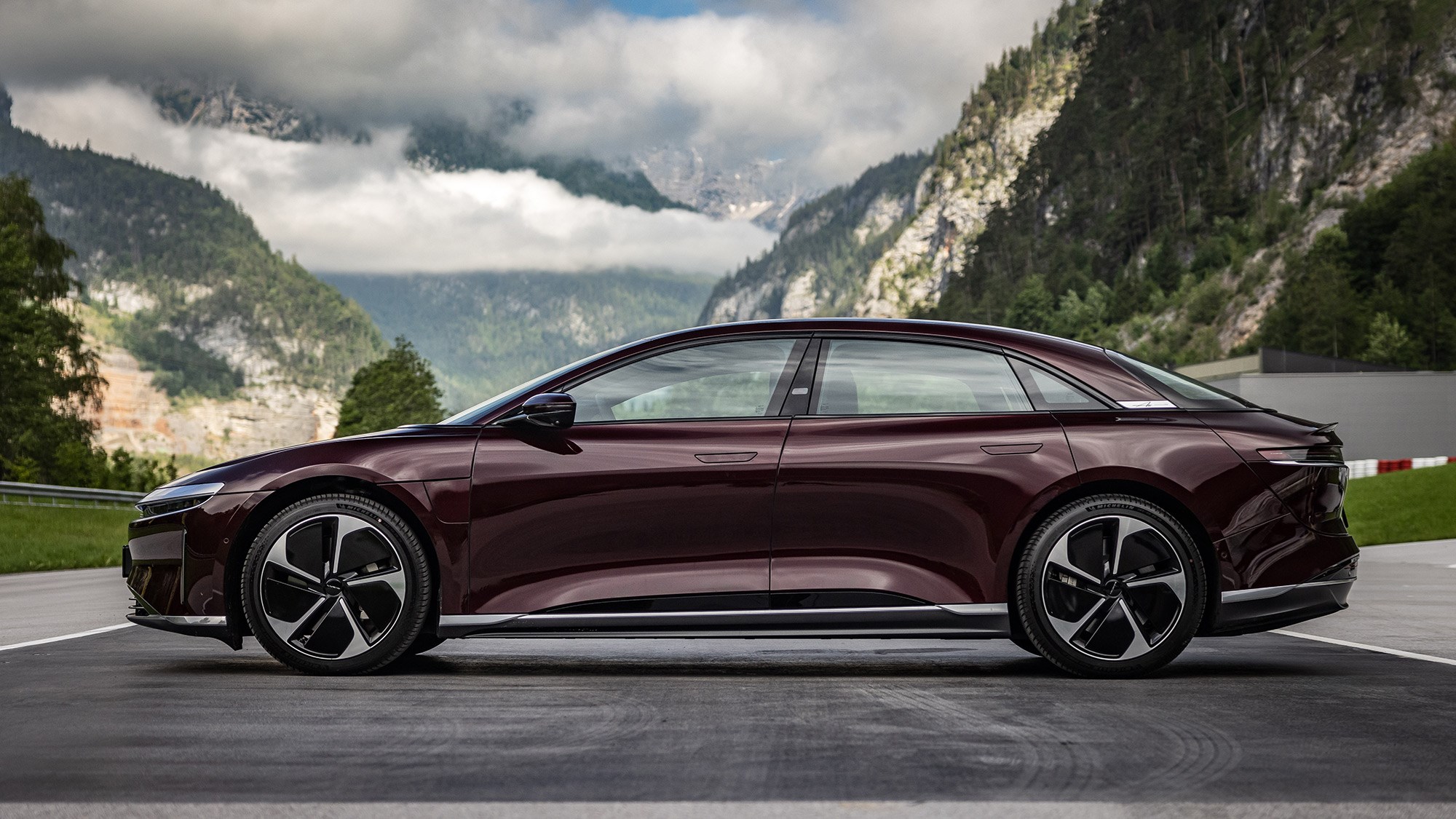
If long range is your objective, you’ll have to trade up to the bigger batteries, swelling the price tag accordingly. The good news is that even the more modest capacities have a range that’ll suit many buyers’ needs and on each occasion we’ve tested an Air our testers have been impressed by the reliability of the range. This is definitely one of the longest range electric cars on sale today.
Charging rates for the Pure stand at 210kW, so you’ll add range in a jiffy if you can find a fast enough DC charger. The all-wheel drive Pure and Touring charge at 250kW, rising to 300kW on the top two specs with their 900-volt architecture. Rest assured, this is a very fast-charging EV.
How does the Lucid Air drive?
At a gentle cruise, it’s a zen-like experience. The ride is relaxing, and the slight patter we experienced on 21-inch wheels in the US seems to have been dialled back for European models. The way it deals with big bumps is astonishing. They’re absorbed beautifully, all the more impressive given the vehicle’s overall two-tonne kerbweight. The suspension is by four-ball-joint double wishbones all round and adaptive dampers; air suspension is conspicuous by its absence on all the test cars at the European debut.
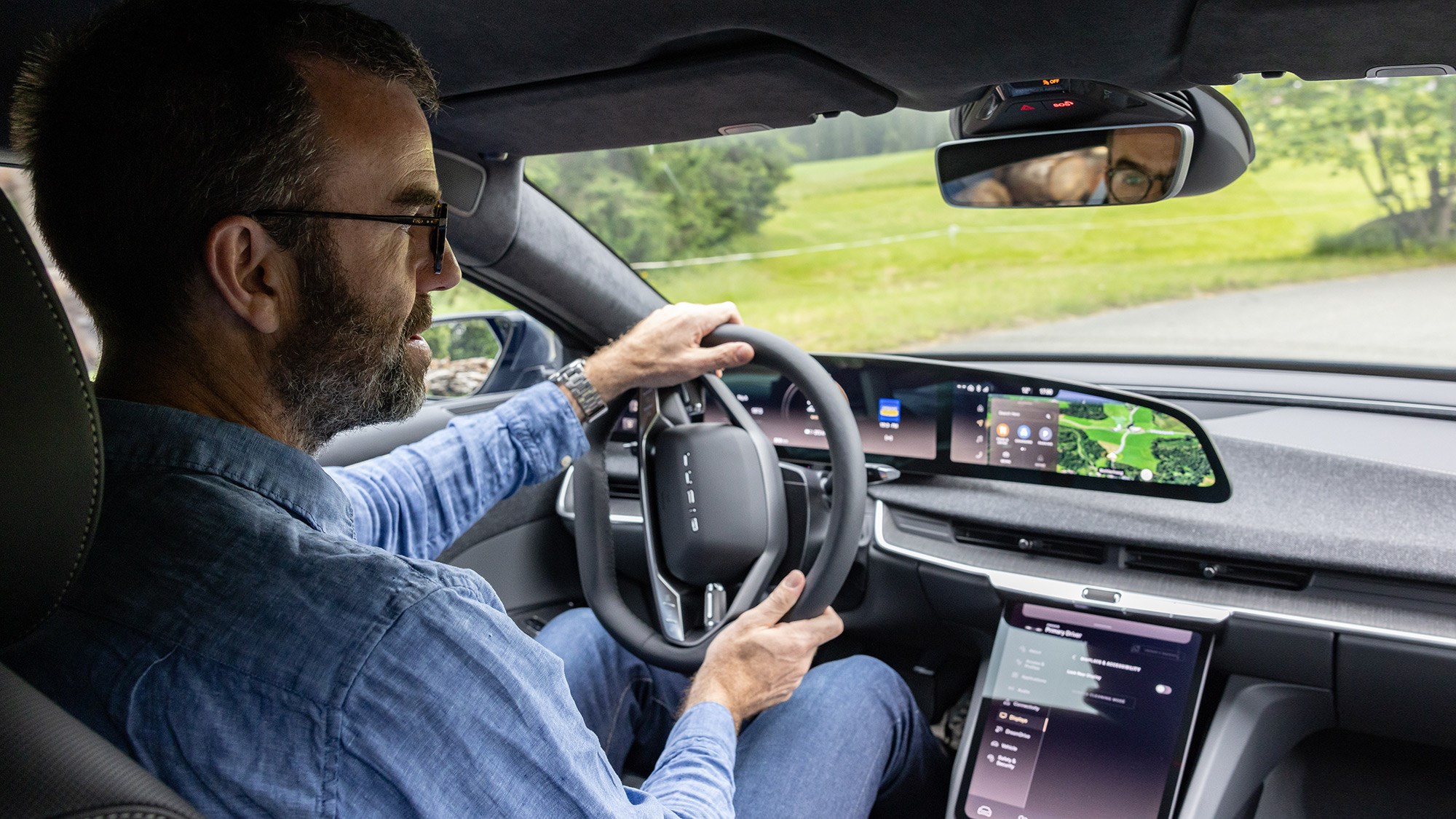
In search of more exciting roads, we head to the ÖAMTC Saalfelden Driver Training Centre in Austria. It’s here that Lucid CEO Rawlinson’s seemingly unlikely claim – that the Air can feel luxurious like a Mercedes-Benz S-Class yet handle like a sports car – is proved confoundingly true.
The way this car changes direction is almost Lotus-like. The steering, linear but numb at lower speeds, comes alive on track – direct and with no fight or kickback over bumps. Overall composure at speed is quite something, too: mid-corner bumps pose no threat and even in the wet the Lucid Air handles tidily, the stability control and electro-nannies metering out the power with delicacy, occasionally nudging the car back into line if you’re too busy with the accelerator.
And what speed. The Air feels hypercar-quick out of corners when equipped with dual motors. With big brakes at each corner and oodles of front-axle grip, you’ve confidence on the way into them, too. This car wasn’t designed as a straight-line dragster (although the Dream Edition Performance variant can hit 0-62mph in 2.7sec) – it’s the way it accelerates above 60mph, and never really lets up, that impresses. And all in near-serenity; the slightly intrusive gear whine we encountered at the American launch has been addressed and the European cars we’ve tested were impressively quiet in this regard.
There’s enough roll to place the car, then seemingly limitless grip. In Sprint mode – which gives you the option to turn off the stability control, not possible in all EVs – it’s more rapid still yet eminently controllable, despite all that power on tap.
Take a moment to consider the energy consumption we achieved during our time with the Lucid Air Pure: I drove the car from Munich to Kitzbühel and across the Tyrolean Alps, making steady progress on autobahns above 100mph where safe to do so, yet still returned 4.0 miles per kilowatt hour. Its EV efficiency is staggering and a major selling point.
Lucid Air vs BMW i7 vs Mercedes-Benz EQS vs Tesla Model S
What about the interior?
This is a roomy cabin, with limousine levels of space on offer front and rear. Roominess in the back seats is impressive and matches anything you’ll find in a top-spec Teutonic luxury car. The airy cockpit is matched by a high-tech dashboard that majors on touchscreens and enough physical controls (for heating and the most-used daily functions) for a good balance of digital/physical touchpoints.
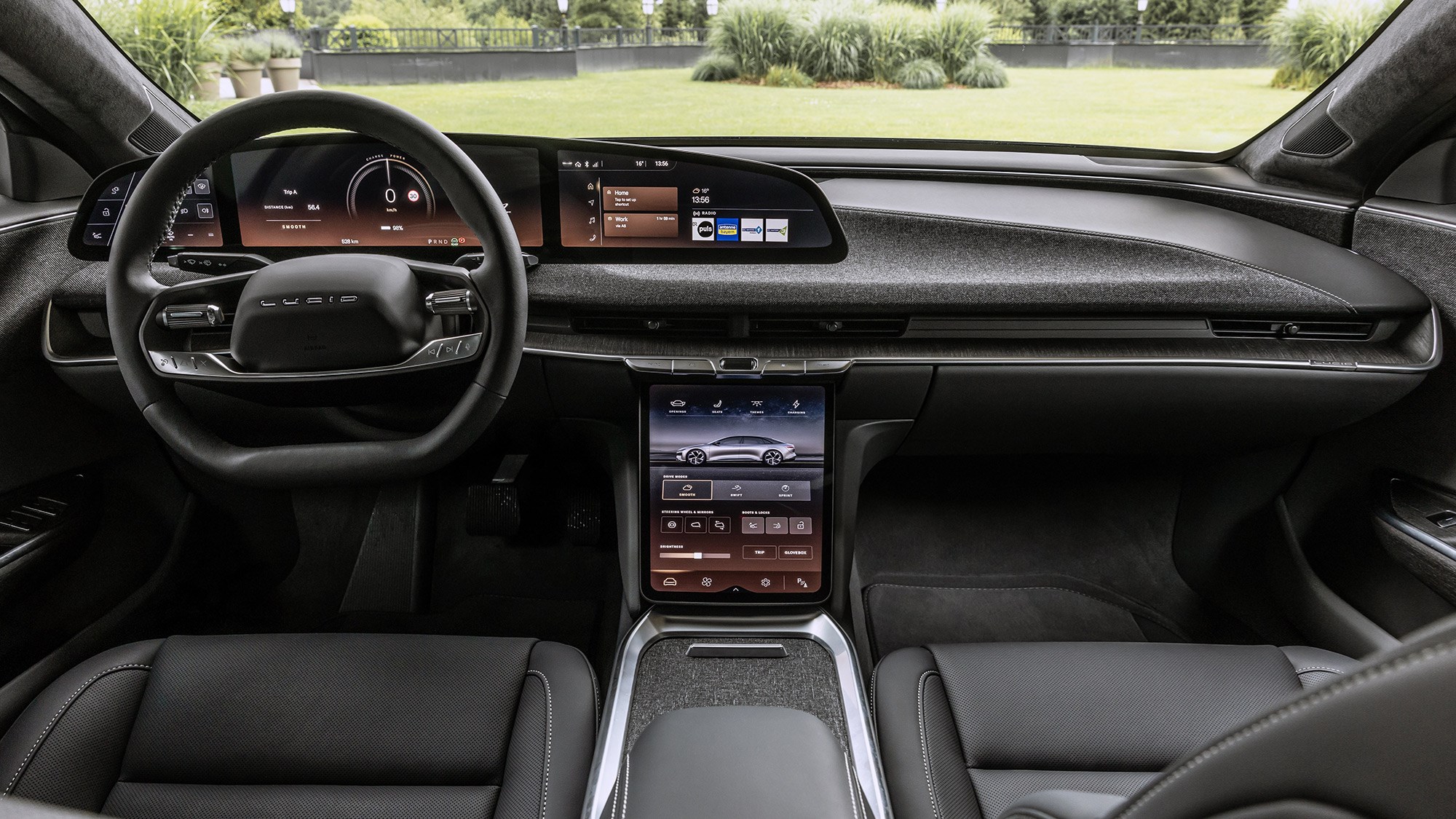
It’s bright and airy, too, especially when equipped with the wrapover windscreen that creates an infinity pool of glass merging into a clear roof. Lower-spec Pure models stick with a conventional screen/header-rail/roof set-up as standard, but one quirk of the design is a very thick, low-set A-pillar which can restrict vision in some corners. You quickly adapt, but it’s one of the few ergonomic weak spots of the car. Blame the super-smooth aerodynamics and 0.197 drag coefficient for the low-slung roofline. It doesn’t affect headroom, just your vision out.
Displays are split between two surfaces – a compound-curved 5K display for the instrument panel, with a touch-sensitive section, and a lower conventional tablet (which whirrs into the hiding inside the dash on request, allowing access to a big cavity for storage behind it).
The ability to swipe music and nav menus from the top curving screen ‘through’ the dashboard to the bigger touchscreen below is clever and allows you to place the information you want where you want. The software was a little laggy on early pre-prototypes, but the EU production cars’ infotainment worked seamlessly. Connectivity to Apple CarPlay and Android Auto is a given.
Before you buy (trims and rivals)
The Air launched in the US with 520 Dream Edition models to celebrate its EPA-rated 520-mile range, but the product line-up has consolidated into a simpler structure for European sales:
- Pure: Prices from €85,000 (£71,800)
- Touring: Prices from €99,000 (£83,700)
- Grand Touring: Prices from €129,000 (£109,000)
- Dream Edition: Prices from €218,000 (£184,000)
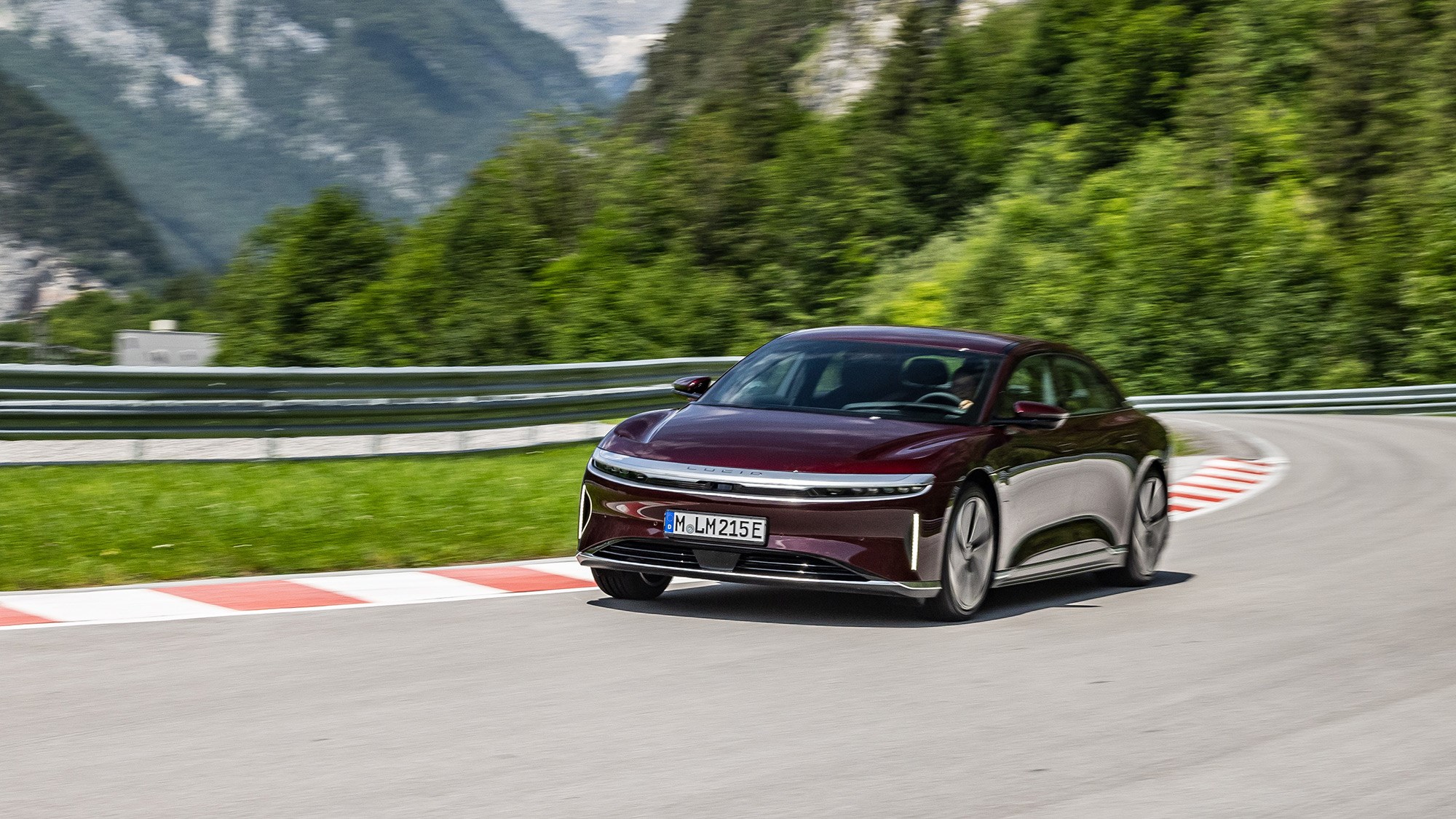
You can now buy the Lucid Air in Germany, Switzerland, the Netherlands and Norway and the company is taking a softly-softly approach to the European market. Insiders confirm to CAR that the Air will not be engineered for right-hand drive, suggesting that right-hookers will be reserved for the 2025 Lucid Gravity SUV.
Then there’s the upcoming third model, dubbed a ‘mid-sized EV’ and expected to morph into an innovative Tesla Model Y rival when it arrives in 2027. Where the Gravity uses an adapted Air platform, the third model will usher in Lucid’s second-generation, all-new architecture which promises even better efficiency and value. If the company can maintain its current innovation trajectory, that promises to be quite a car.
Verdict: Lucid Air
CAR magazine’s seasoned road testers have been exposed to all sorts of vapourware over the years and we’re accustomed to divining the magic from the muck. Four of our road testers have now driven the Air and we all agree: Lucid Motors on the cusp of something special and deserves to prosper. It has a top-notch engineering pedigree, a progressive attitude to innovation and the chops to back up those bold claims with frankly staggering efficiency and long range, the most important attributes for any electric car.
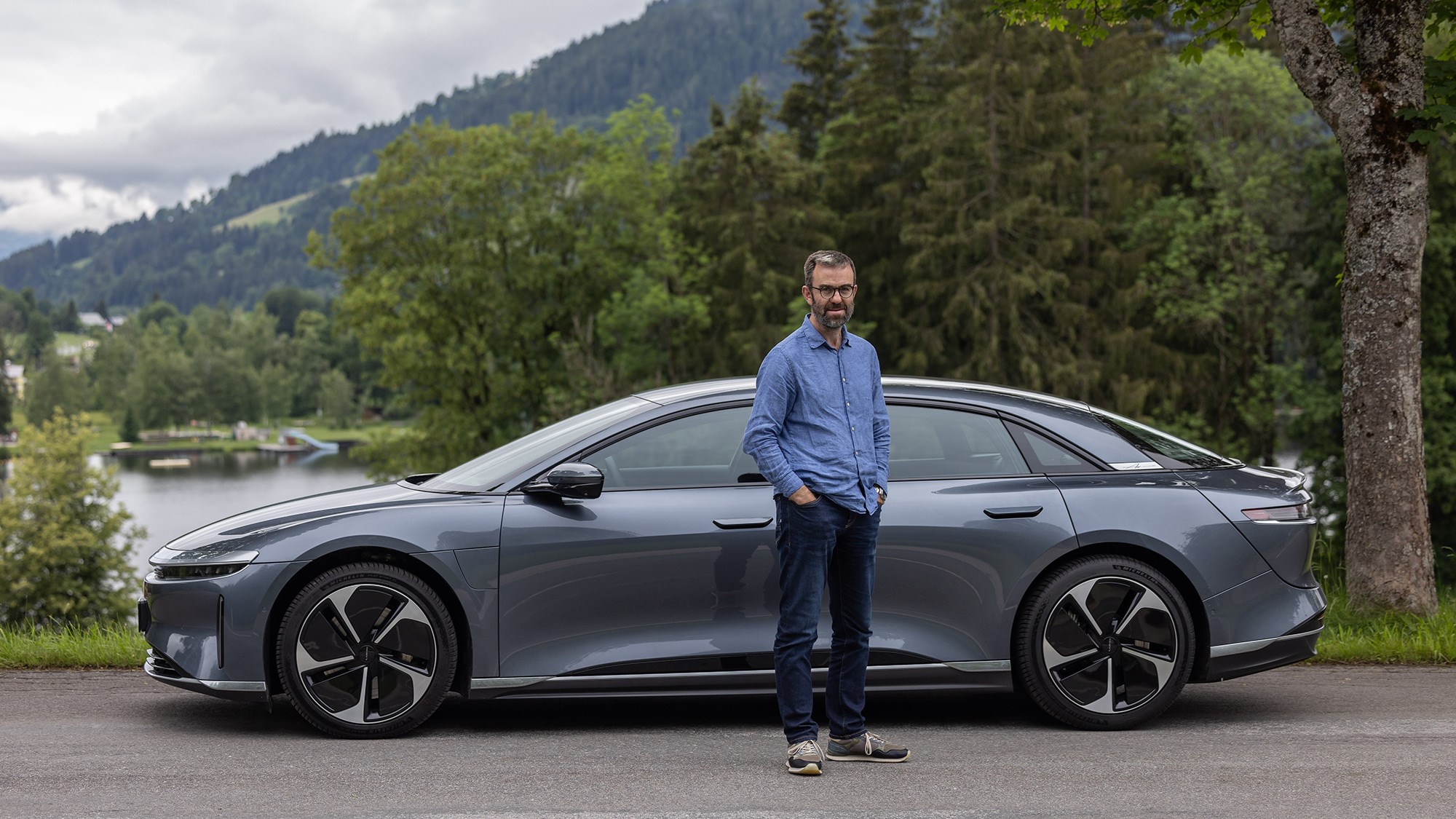
No other EV manufacturer gets close to the Air’s energy consumption. That this super-sized luxury sports limo uses less electricity than a humble Fiat 500e is staggering. That it also packages so much space into the footprint of an Audi A6, is built to an impressively mature quality and packs features galore is the cream on top.
It feels like we’ve had a glimpse of the future. If Lucid’s bold approach pays off, this is the electric car, version 2.0.